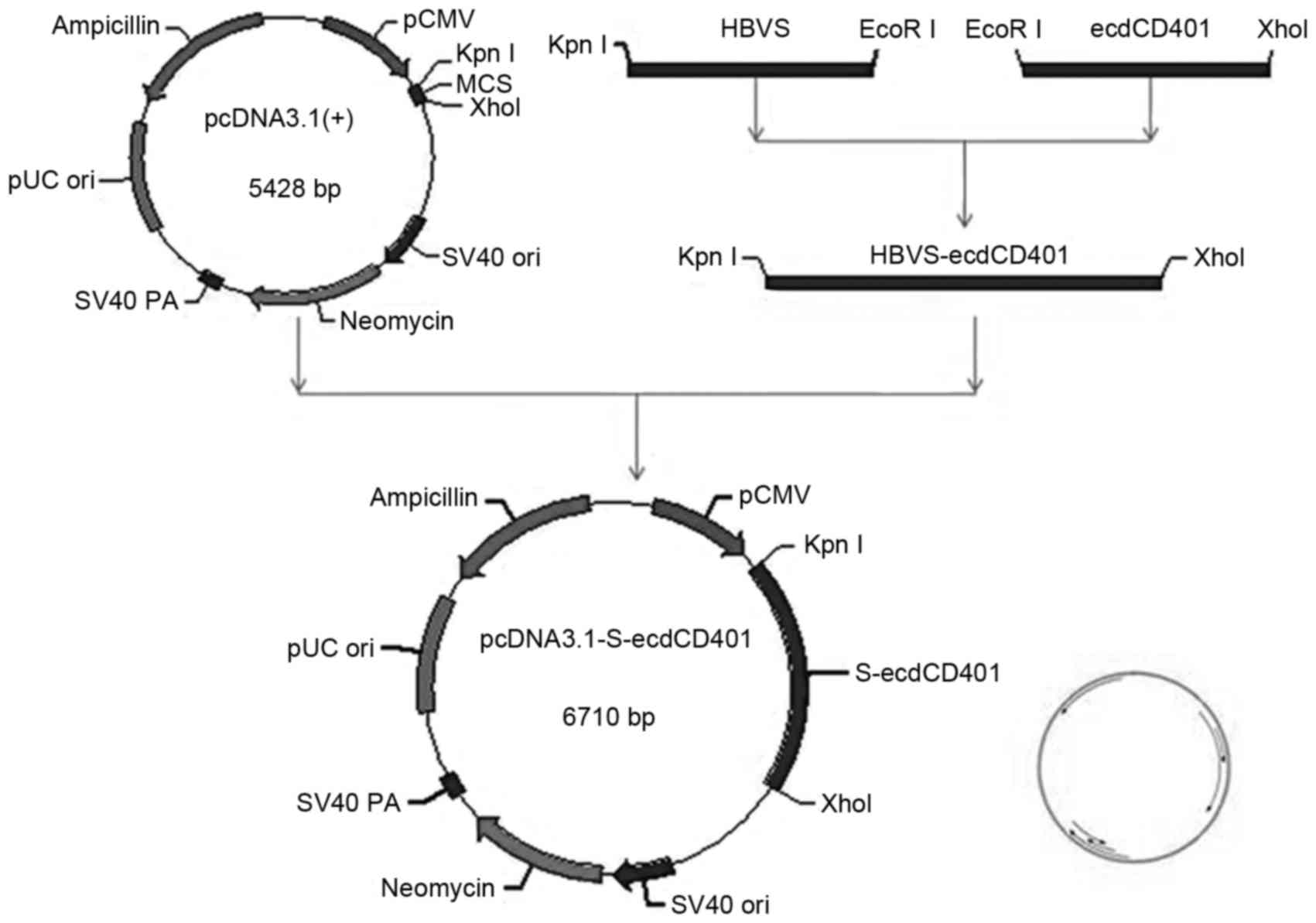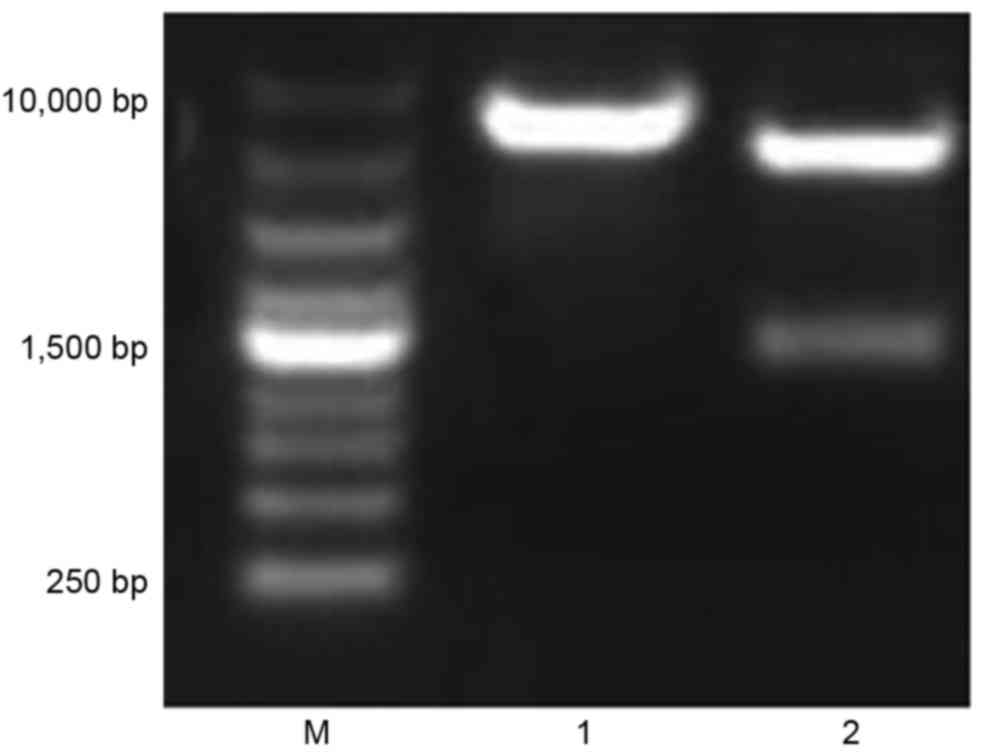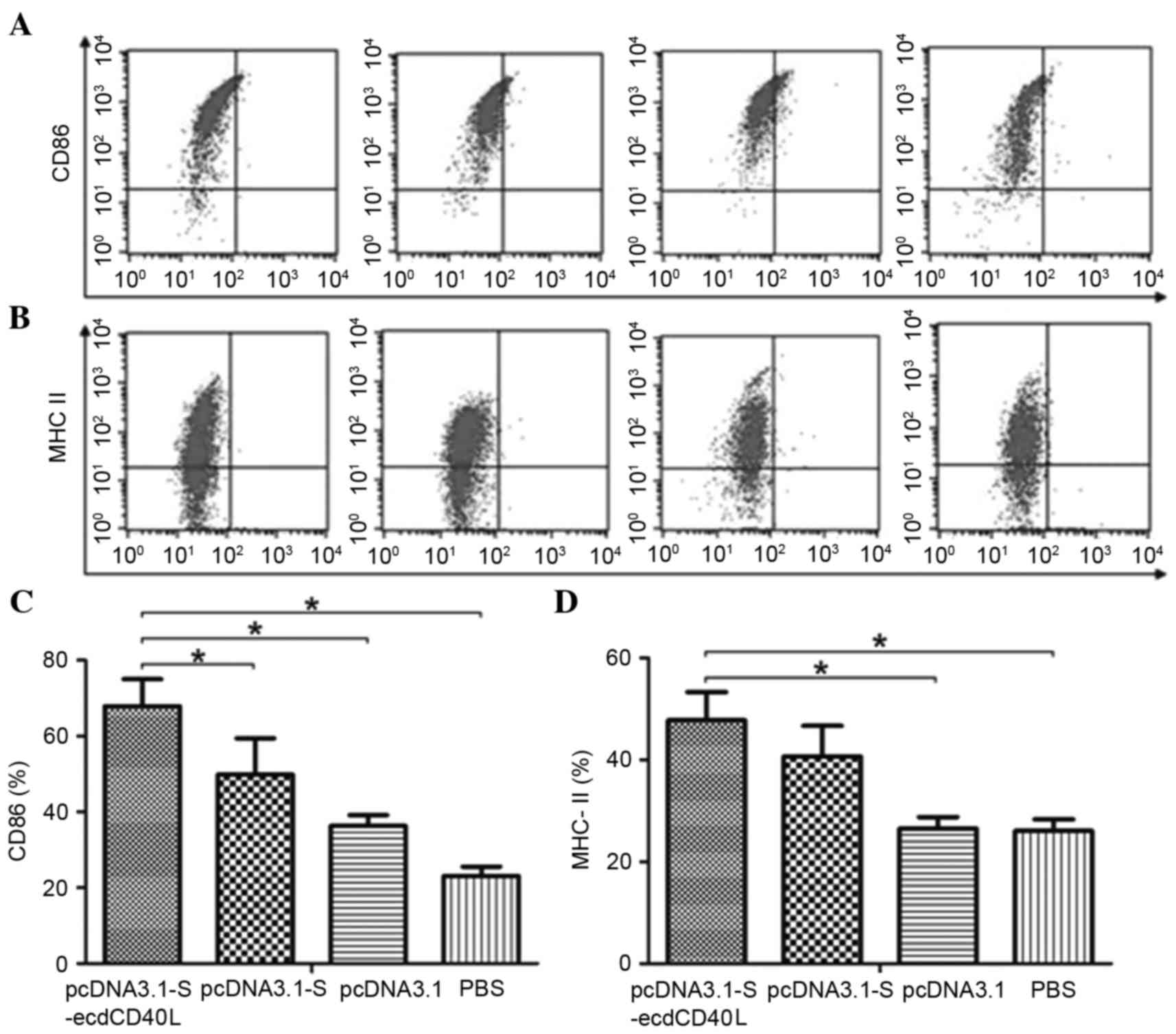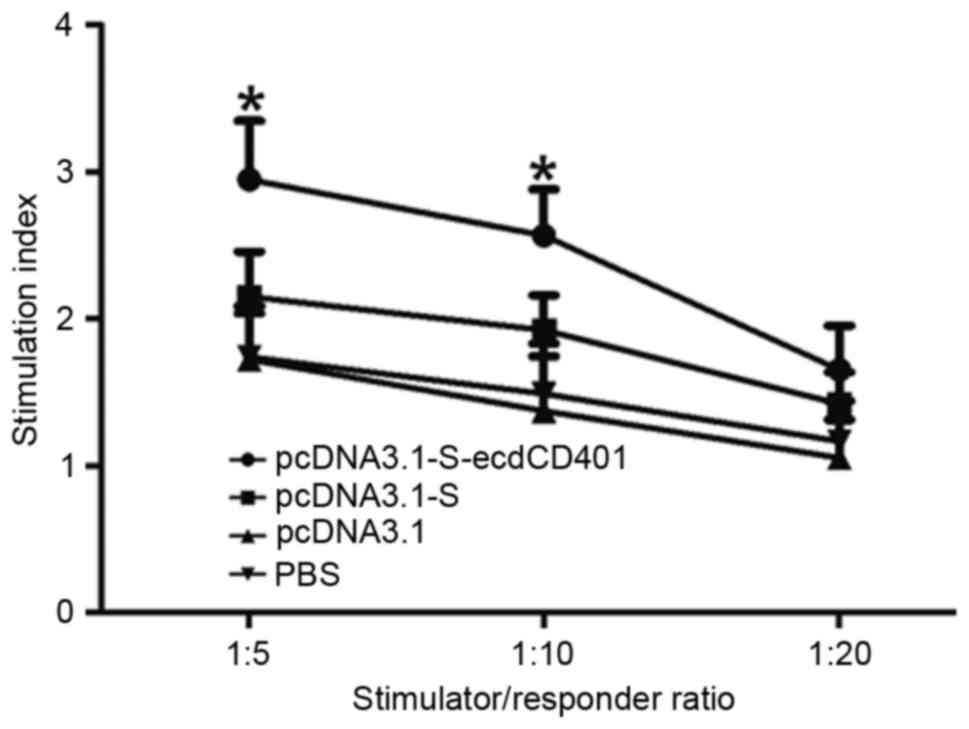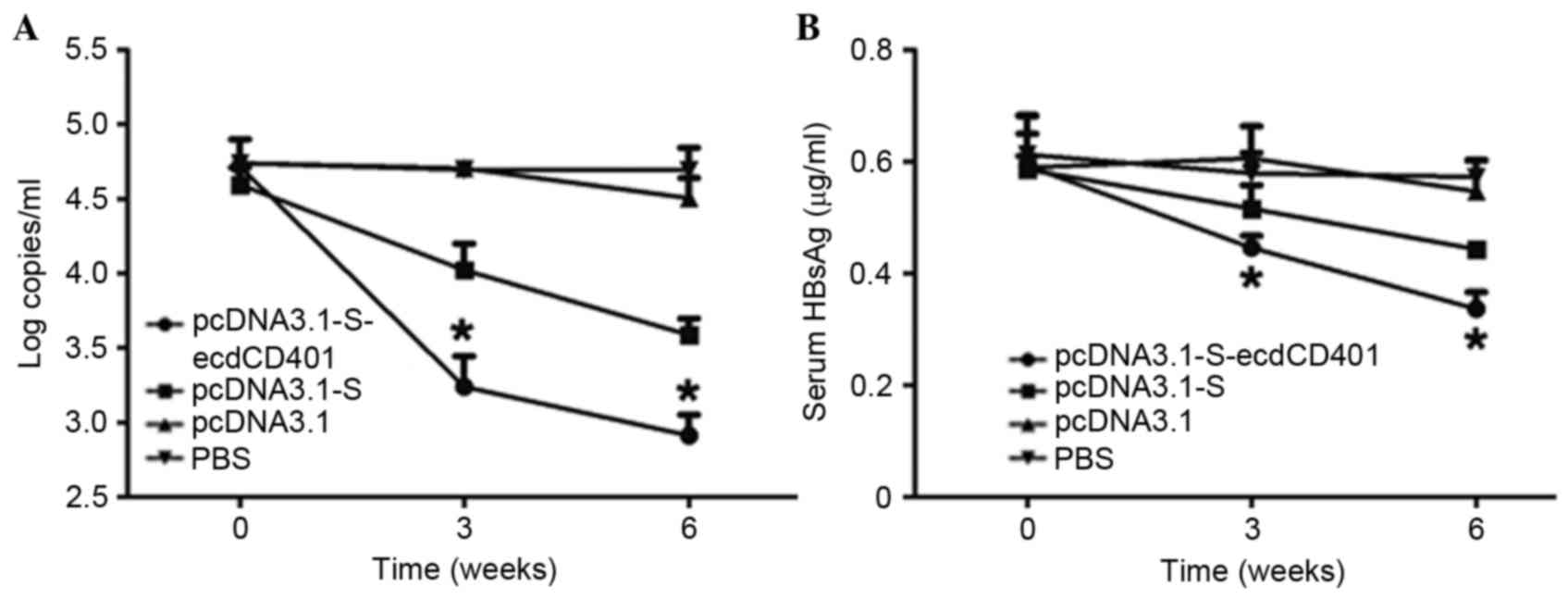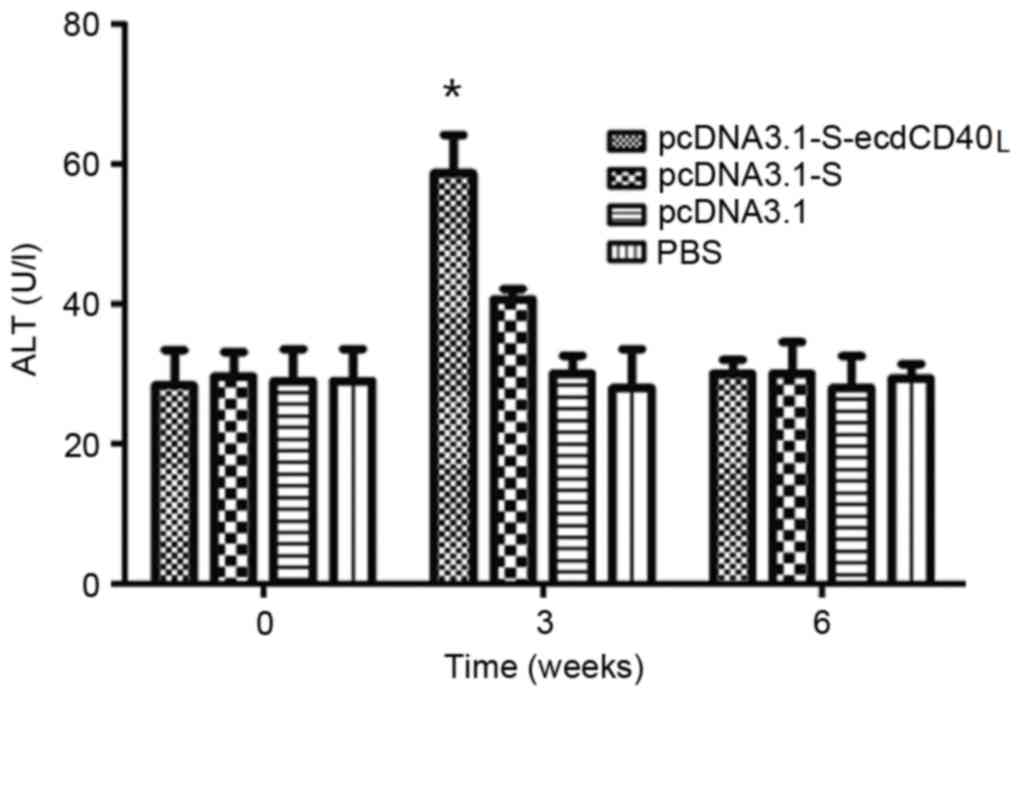Effect of the hepatitis B virus S‑ecdCD40L vaccine therapy in HBV transgenic mice: A vaccine‑induced activation of antigen presenting dendritic cells
- Authors:
- Published online on: August 22, 2017 https://doi.org/10.3892/mmr.2017.7322
- Pages: 6102-6108
Abstract
Introduction
Approximately one third of the world's population has serological evidence of past or present infection with hepatitis B virus (HBV), and >350 million people are chronic HBV surface antigen (HBsAg) carriers at high risk of developing liver cirrhosis and hepatocellular carcinoma (1). Currently, treatment options for chronic hepatitis B (CHB) mainly depend on interferon-α or nucleoside/nucleotide analogs, which control virus replication efficiently but rarely clear the virus completely (2). Hence, various novel vaccine approaches, including DNA vaccines, have been developed for better therapeutic effect of hepatitis B (2,3).
Therefore, the principal therapeutic goal for treating patients chronically infected with HBV is to successfully stimulate an immune response, with the aim of leading to effective viral clearance. Due to an increasing capacity to elicit T-cell immune response, a DNA vaccine may be a more effictive technique to stimulate specific cellular immune responses compared with a recombinant protein-based vaccine (4–6).
Dendritic cells (DCs) are the most significant antigen presenting cells (APCs), and serve a central role in antiviral immunity with a unique capacity to bridge innate and adaptive immunity (7). However, DCs are functionally impaired in patients with CHB (8). As the interaction between the virus and the host determines the magnitude of the virus-specific immune response (9), defective processing and presentation of the HBV by antigen presenting DCs may be responsible for the impaired HBV-specific immune responses in CHB carriers. Therefore, enhancing DC function and inducing a specific immune response may be effective for viral clearance.
The CD40 ligand (CD40L), a member of the tumor necrosis factor (TNF) gene family, is preferentially expressed on activated CD4+ T cells (10,11). The receptor of CD40L is CD40, which is expressed on APCs, including on DCs. Previous studies have demonstrated that CD40 and CD40L interactions are prominent in the maturation of dendritic cells and additionally enhance the ability of DCs to induce a T-cell response (12–14).
Our previous study successfully constructed plasmids that contain the HBV S-ecdCD40L fusion gene (pcDNA3.1-S-ecdCD40L), which may promote DC activation and enhance their function, with the aim to develop a novel type of hepatitis B vaccine (15). In the present study, it was hypothesized that HBV S-ecdCD40L therapeutic vaccines will promote the maturation and activation of DCs and thus, may enhance the antigen-specific T-cell generation of HBV transgenic mice to control and eliminate the HBV virus.
Materials and methods
Reagents and materials
RNAiso reagent, a BCaBEST RNA PCR kit, restriction endonucleases (KpnI, EcoRI and XhoI), a T4 DNA ligase and ExTaq polymerase were purchased from Takara Biotechnology Co., Ltd. (Dalian, China). Polymerase chain reaction (PCR) primers were synthesized by Generay Biotech Co., Ltd. (Shanghai, China). DNA sequencing was performed by Generay Biotech Co., Ltd. RPMI-1640 medium was purchased from Gibco; Thermo Fisher Scientific, Inc. (Waltham, MA, USA). The recombinant plasmid (pcDNA3.1-S), the expression vector [pcDNA3.1 (+)] and Escherichia coli DH5α were maintained in the authors' laboratory at The First Affiliated Hospital of Wenzhou Medical University (Wenzhou, China). Recombinant murine granulocyte/macrophage colony-stimulating factor (GM-CSF), recombinant murine interleukin (IL)-4 were purchased from PeproTech, Inc. (Rocky Hill, NJ, USA). The mouse CD11c magnetic bead sorting kit and CD4+ T isolation kit were purchased from Miltenyi Biotech (Bergisch Gladbach, Germany). Allophycocyanin-conjugated anti-CD11c monoclonal and corresponding homotype antibodies [Phycoerythrin (PE)-conjugated anti-CD86 (cat. no. 12-0869-41); R at IgG2b K Isotype Control PE/Rat IgG2b K Isotype Control FITC; cat. no. 12-4031/11-4031; APC anti-human CD11c antibody; cat. no. 301613; (MHC)-II antibody cat. no. 561107] were purchased from BioLegend (USA). Phycoerythrin (PE)/fluorescein isothiocyanate (FITC)-conjugated anti-CD11c, anti-CD86 and anti-major histocompatility complex (MHC)-II for fluorescence-activated cell sorting (FACS) analysis were purchased from eBioscience, Inc. (San Diego, CA, USA). Cell Counting kit-8 (CCK-8) was purchased from Beyotime Institute of Biotechnology (Haimen, China). ELISA kits (cat. no. MAB611) specific for mouse IL-12p70 were purchased from R&D Systems, Inc. (Minneapolis, MN, USA). The HBV fluorescence quantitative PCR Diagnostic kit was purchased from Shenzhen Piji Biotech (Shenzhen, China).
Animals
A total of 20 HBV transgenic (HBV-Tg) BALB/c mice (age, 8–10 weeks; weight, 18–25 g) were purchased from the Infectious Disease Center of No.458 Hospital (Guangzhou, China). A total of 20 C57BL/6 mice (age, 6–8 weeks; weight, 18–25 g) were purchased from the Shanghai Slac Laboratory Animal Center, Chinese Academy of Sciences (Shanghai, China). All the mice (n=40) were maintained under a pathogen-free facility with controlled temperatures (20–22°C), humidity (45–55%) and a 12-h light/dark cycle lights on from 08:00 to 20:00. This study was carried out with ethical approval from of the Institutional Animal Committee of Wenzhou Medical University (Wenzhou, China) and all mice received care throughout the experiment in accordance with ‘Guide for the Care and Use of Laboratory Animals’ (National Institutes of Health, Bethesda, MD, USA).
Construction of the pcDNA3.1-S-ecdCD40L
A 650 bp cDNA fragment coding for the full open reading frame of the murine ecdCD40L gene was cloned from murine lymphocytes of C57BL/6 mice by PCR using Ex Taq polymerase. The following primers for the ecdCD40L gene were used: Forward, 5′-TTAGAATTCCTTCATAGAAGATTGGATAAGGTCGAA-3′ and reverse, 5′-GCGCTCGAGTTAGAGTTTGAGTAAGCCAAAAGA-3′. A 670 bp DNA fragment coding for the HBV S gene was cloned by PCR from a recombinant plasmid containing two times the length of HBV sequence (PCP10), which was obtained from Dr Cheng Jun (Infectious Disease Center, Beijing Ditan Hospital, Beijing, China). There were two primers specific for the HBV S gene that were used: Forward, 5′-GCGGGTACCATGGAGAACATCACATCAGGATTC-3′ and reverse, 5′-GGAGAATTCGCCGCCGCCGCCAATGTATACCCAAAGACAAAAGAAAAT-3′. Following this, the pcDNA3.1-S-ecdCD40L vaccine was constructed, as described previously (15).
Immunization schedule
HBV-Tg mice randomly allocated into four groups (n=5 per group) received intramuscular injections in the tibialis anterior muscles as follows: Group A, 100 µg pcDNA3.1-S-ecdCD40L in 100 µl 0.9% saline; and groups B, C and D, 100 µg pcDNA3.1-S, pcDNA3.1 in 100 µl 0.9% saline and 100 µl PBS. Intramuscular injections for the negative control were performed by injecting PBS using a 1 ml insulin syringe with a 28-gauge needle. All mice were immunized on day 0 and boosted on days 14 and 28.
Isolation of dendritic cells
A total of 6 weeks following the first immunization, liver DCs were isolated from the mouse liver according to established protocols with minor modifications as magnetic-activated cell sorting was used (16). The mice were anaesthetized with 10% chloral hydrate. Following opening of the abdomen, the needle of a 1 ml syringe was inserted into the portal vein and the liver was perfused with Hanks' Balanced Salt solution containing 1% type IV collagenase and 0.19 g/l EDTA (Beijing Leagene Biotechnology, Co., Ltd., Beijing, China). The inferior vena cava was cut to free outflow of blood. The perfused liver was removed and disrupted with ophthalmic forceps. The cell suspensions were passed through a sterile strainer (pore size, 74 µm), and subsequently resuspended in 35% percoll solution. Following centrifugation at 450 × g for 20 min at room temperature, non-parenchymal cells (NPCs) of the liver were collected. In order to isolate liver DCs, NPCs were purified with a CD11c magnetic bead sorting kit according to the manufacturer's protocol. CD11+cells of ≥90% purity (often ~95% purity) were used in experiments. Subsequently, CD11c-enriched cells were cultured overnight in complete medium.
Flow cytometry
To characterize and compare the expression of surface molecules on DCs, flow cytometry was performed. DCs were washed and stained in PBS for 30 min at 4°C with PE- or FITC-conjugated monoclonal antibodies against CD86 and MHCII (dilution 1:50). Isotype-matched antibodies (Rat IgG2b K Isotype Control PE/Rat IgG2b K Isotype Control FITC, cat no. 12-4031/11-4031, eBioscience Inc., USA) served as FITC- or PE-conjugated controls, incubation at 4°C for 20 min. Stained cells were centrifuged with PBS (5 min, 300 × g at 4°C), the supernatant was discarded and 1% paraformaldehyde 200 µl was added every tube to fix the DCs at 4°C. Stained cells were then analyzed using an Elite flow cytometer (Beckman Coulter, Inc., Brea, CA, USA).
Cytokine ELISA
Cytokine levels in the supernatants were measured by an ELISA kit specific for IL-12p70 (cat. no. MAB611; R&D Systems, Inc., Minneapolis, MN, USA) according to manufacturer's instructions, at a wavelength of 450 nm using a microplate reader.
Allogeneic-mixed lymphocyte reactions (MLRs)
T cells were purified from the spleen lymphocytes of C57BL/6 mouse using a CD4+ T isolation kit. Briefly, graded concentrations of DCs from different groups were co-cultured in U-bottom 96-well plates with constant number of allogeneic T-cells (1×105 cells/200 ml) at different stimulator:responder (DC:T-cell) ratios (1:5, 1:10, 1:20) for 96 h at 37°C. The T-cell stimulatory activity of DC populations in MLR was expressed as stimulation index (SI) value and measured using CCK-8 assay in accordance with the manufacturer's protocol.
HBV DNA quantitation
At weeks 0, 3 and 6 following immunization, blood was collected from the mice orbital sinus and 50 µl sera were collected for HBV DNA assay. Quantitative PCR (qPCR) was performed to quantify HBV DNA using an HBV DNA PCR-FIUOTEC kit (Sun Yat-sen University, Guangzhou, China) with a detection limit of 500 copies/ml. The fluorescent signals were quantified by PRISM 7000 Sequence Detection system version 1.2.3 (Applied Biosystems; Thermo Fisher Scientific, Inc.).
Serum HBsAg and alanine aminotransferase (ALT) analyses
Frozen serum samples collected from the immunized mice were transferred to the reference lab at The First Affiliated Hospital of Wenzhou Medical University for assays of HBsAg and serum ALT levels. The Modular E170 analyzer (Roche Diagnostics, Basel, Switzerland) was employed for HBsAg assay. ALT activity was quantified by the AU5800 automatic analyzer (Beckman Coulter, Inc.).
Statistical analysis
Data analysis was performed using SPSS software (version 18.0; SPSS Inc., Chicago, IL, USA). Data are expressed as the mean ± standard deviation. Statistical analysis was performed using one-way analysis of variance followed by LSD-t or Dunnett's T3 post hoc tests for multi group comparisons. P<0.05 was considered to indicate a statistically significant difference.
Results
Construction and characterization of the recombinant plasmid pcDNA3.1-S-ecdCD40L
The recombinant plasmid was constructed and used for DNA vaccination (Fig. 1). Following construction, the recombinant plasmids were characterized by digestion with restriction enzymes Xho I/KpnI and EcoRI (Fig. 2). The fragment digested from the recombinant plasmids by EcoRI was ~6,700 bp in size, as expected. The fragment digested from the recombinant plasmids by Xho I/Kpn I was ~1,500 and 5,200 bp, as expected. The result confirmed that the inserted HBV S-ecdCD40L fusion gene had the correct reading frame and length.
Vaccination induces activation of DC with upregulated expression of CD86 and MHC-II
To evaluate the phenotypic alterations induced within liver DCs, purified DCs from the liver of pcDNA3.1-S-ecdCD40L-treated transgenic mice, as well as the controls, were subjected to phenotypic analysis by flow cytometry (Fig. 3A and B). The expression of MHC molecules and co-stimulatory molecules serve an essential role in the maturation of dendritic cells, which interact with T cells for T cell activation (17). The results demonstrated an evident upregulated expression of CD86 in DCs from the pcDNA3.1-S-ecdCD40L-treated transgenic mice compared with the other three groups (Fig. 3C; P<0.05). In addition, the proportion of DCs that were positive for MHC-II was increased in the pcDNA3.1-S-ecdCD40L group, but showed no significant difference when compared with the pcDNA3.1-S group (Fig. 3D; P>0.05).
IL-12p70 production by DC
The production of IL-12, which is known to induce T-cell proliferation, was assessed. Spontaneous IL-12 production of DCs in the supernatants of four groups is presented in Table I. Compared with the three control groups, IL-12 secretion by DCs from pcDNA3.1-S-ecdCD40L-treated transgenic mice was significantly greater (P<0.05).
Vaccination significantly enhances allogeneic T-cell proliferation in DCs
To determine the functional properties of DCs, the T-cell stimulatory capacity, expressed as a stimulation index (SI) value, in an MLR was examined. SI is the ratio between the proliferative response (optical density) of T cells in the presence and the absence of DCs in the cultures at different DC/T cell ratio. As presented in Fig. 4, although the number of T cells was the same in all MLR cultures, the SI went up significantly according to the increasing DCs number. The results showed that DCs from HBV-Tg mice immunized with pcDNA3.1-S-ecdCD40L tended to have significantly increased T-cell stimulatory activity (P<0.05), when compared with the other three groups at the DC/T ratios of 1:5 and 1:10. However, when DC/T was 1:20, there was no significant difference between the four groups (P>0.05).
HBV-S-ecdCD40L vaccination results in the downregulation of HBV-DNA and the clearance of HBsAg in HBV transgenic mice
The HBV transgenic mice used in the current study had a high-level titer of HBV DNA in their sera prior to immunization. qPCR results revealed that pcDNA3.1-S-ecdCD40L may significantly inhibit HBV DNA replication. Particularly following the third injection, the decrease was obvious (Fig. 5A; P<0.05). Furthermore, HBsAg significantly dropped in the sera following the vaccinations (Fig. 5B; P<0.05). The HBV S-ecdCD40L vaccine resulted in a more rapid downregulation of HBsAg. The reduced levels of serum HBV DNA were observed in pcDNA3.1-S-ecdCD40L or pcDNA3.1-S vaccine-recipients, but not in pcDNA3.1- and PBS-vaccinated HBV-Tg mice. In addition, reduced levels of serum HBV DNA and HBsAg were observed in pcDNA3.1-S-ecdCD40L and pcDNA3.1-S vaccine-recipients, but not in pcDNA3.1- and PBS-vaccinated HBV-Tg mice.
Evaluation of liver injury
An important question was whether an immunization inducing immune responses in HBV-Tg mice would result in inflammation or damage of the liver. Liver injury was evaluated by determining ALT activity, which indicated hepatocyte damage in the sera of the immunized mice. The results demonstrated that ALT activity rose following HBV S-ecdCD40L vaccination, and subsequently returned to the baseline level (Fig. 6). ALT increased to a high level at week 3 in HBV-Tg mice, then dropped back to the basal level.
Discussion
Despite the presence of an effective prophylactic vaccine, ~1 million patients with CHB succumb to disease annually from liver cirrhosis or hepatocellular carcinoma (18).
The ultimate goal of therapy for CHB is the eradication of HBV or persistent suppression of viral replication, in order to improve quality of life and survival by preventing disease progression. However, clinical therapeutic drugs for CHB infection often do not lead to satisfactory results. Previously, DNA vaccination has emerged as an attractive approach, and has demonstrated importance in antiviral application due to its ability to induce T cell responses (19).
CHB is an immune-mediated disease. There is a general consensus that a combination of antiviral treatment and immunomodulation is essential to achieve a sustained control of HBV infection (20). The classical DNA vaccination plasmid only encodes for a single viral antigen, the S or the PreS2/S antigen, and its immunogenicity remains relatively low (21). Only a few injected DNA molecules are taken up by APCs, which leads to a minority of the corresponding proteins being presented (22). Many strategies have been employed to improve the efficacy of DNA vaccination. In the present study, eukaryotic expression plasmids of the HBV S-ecdCD40L fusion gene were constructed to promote DC maturation as well as induce specific immune responses to HBV. The HBV-Tg mice model was used as a surrogate model for its persistent HBV infection following neonatal transmission to validate the HBV S-ecdCD40L vaccine's antiviral effect. To date, studies have illustrated the usefulness of HBV-Tg mice in elucidating the viral biology and host/viral interactions when they are used to address questions that cannot be otherwise approached by the existing methodology in human HBV carriers (23,24).
It is important for therapeutic vaccine to be able to induce potent T-cell responses. However, the induction of efficient T-cell response requires equally effective cross-presentation of the exogenous vaccine antigens by professional APCs (25). It is widely accepted that DCs, the most potent type of APC, serve essential roles in priming the T-cell response (26). The structure of CD40L, the ligand for CD40 on DCs, includes extracellular, transmembrane and intracellular parts. The extracellular domain of CD40L (ecd40L) may combine with CD40 and promote the maturation of DC and enhance its function (27).
A previous report indicated that an Ad-sig-E7-ecdCD40L vector may activate DCs with a higher level of IL-12 and interferon-γ than controls, and induce increased CD80+ and CD86+ DCs (27). An additional report demonstrated that a vaccine created by attaching the target-associated antigen (TAA) to the ecdCD40L may facilitate the activation and maturation of DCs by promoting the presentation of TAA on the DCs, thus resulting in expansion of TAA specific T cells and B cells (28). Although CD40L is significantly involved in the activation of DCs and is essential for the induction of antigen-specific T-cell response, it has not been investigated as a component of DNA vaccination for chronic HBV infection. Therefore, the vaccine formulation of the present study included the S antigen to offer a large epitope repertoire for the immune system, and murine ecdCD40L to activate maturation of DCs.
Our previous study indicated that activating CD40 by pcDNA 3.1-S-ecdCD40L-mediated HBV S-ecdCD40L expression may induce DC activation with upregulated expression of cytokines (including IL-12) and immune regulatory molecules (15). In addition, activated DC transfects with pcDNA 3.1-S-ecdCD40L stimulated enhanced allogeneic T-cell proliferation (15). Liver DCs, a particular DC subset, are poorly immunogenic when compared with DCs in other compartments (29). A profound impairment in the function of DCs (lack of co-stimulatory molecule expression and decreased production of pro-inflammatory cytokines) has been reported in patients with persistent HBV infection, which may account for HBV ability to escape immune response (8). To study the effect of vaccination on DCs, in the present follow-up study, liver DCs from immunized mice were analyzed by FACS. The results demonstrated that the HBV-S-ecdCD40L vaccine may increase the expression of surface molecules and the production of IL-12. In addition, the allostimulatory activities of DCs were measured in an MLR, and the results indicated that DCs from HBV-Tg mice immunized with pcDNA3.1-S-ecdCD40L tended to have significantly enhanced T-cell stimulatory capacity. These results suggested that the HBV-S-ecdCD40L vaccine may promote activation of DCs, which was consistent with a previous study (15). It may represent a novel effective and promising treatment of chronic HBV infection.
To further evaluate the potential therapeutic efficacy of the vaccination, serum HBV DNA and HBsAg were detected. The results demonstrated that serum HBsAg and HBV DNA were markedly reduced in HBV transgenic mice immunized with the HBV S-ecdCD40L vaccine. During DNA vaccination alone with a gene of HBV S antigen, the reduction in serum HBsAg and HBV DNA was less evident. Furthermore, a potential complication of inducing an immune response against HBV by the vaccination is that this may generate liver injury. However, the result of serum ALT detection suggested that this may not be an issue. The results of liver injury suggested that HBV-S-ecdCD40L vaccination may break immunotolerance and elicit effective antiviral immunity in a mouse model without causing obvious liver injury.
In conclusion, the present study demonstrated that a HBV S-ecdCD40L vaccine may induce DC activation with upregulated expression of immune regulatory molecules including MHCII/CD86, and pro-inflammatory cytokines including IL-12. These DCs are able to stimulate enhanced allogeneic T-cell proliferation. The effect of this therapeutic vaccine was evaluated in a mouse model of CHB. These findings indicated a significant inhibition of HBV DNA replication and downregulation of HBsAg in HBV-Tg mice, without obvious liver injury. Therefore, the HBV-S-ecdCD40L vaccine may offer a novel and effective therapeutic strategy for CHB sufferers.
Acknowledgements
The present study was supported by the Science and Technology Bureau of Wenzhou (grant no. 20140628) and the Zhejiang Provincial Natural Science Foundation of China (grant nos. LY12H03003 and Y2110768).
References
|
European Association For The Study Of The Liver, . EASL clinical practice guidelines: Management of chronic hepatitis B virus infection. J Hepatol. 57:167–185. 2012. View Article : Google Scholar : PubMed/NCBI | |
|
Buchmann P, Dembek C, Kuklick L, Jäger C, Tedjokusumo R, von Freyend MJ, Drebber U, Janowicz Z, Melber K and Protzer U: A novel therapeutic hepatitis B vaccine induces cellular and humoral immune responses and breaks tolerance in hepatitis B virus (HBV) transgenic mice. Vaccine. 31:1197–1203. 2013. View Article : Google Scholar : PubMed/NCBI | |
|
Maini MK, Boni C, Lee CK, Larrubia JR, Reignat S, Ogg GS, King AS, Herberg J, Gilson R, Alisa A, et al: The role of virus-specific CD8(+) cells in liver damage and viral control during persistent hepatitis B virus infection. J Exp Med. 191:1269–1280. 2000. View Article : Google Scholar : PubMed/NCBI | |
|
Michel ML and Loirat D: DNA vaccines for prophylactic or therapeutic immunization against hepatitis B. Intervirology. 44:78–87. 2001. View Article : Google Scholar : PubMed/NCBI | |
|
Li X, Yang X, Jiang Y and Liu J: A novel HBV DNA vaccine based on T cell epitopes and its potential therapeutic effect in HBV transgenic mice. Int Immunol. 17:1293–1302. 2005. View Article : Google Scholar : PubMed/NCBI | |
|
Thermet A, Rollier C, Zoulim F, Trepo C and Cova L: Progress in DNA vaccine for prophylaxis and therapy of hepatitis B. Vaccine. 21:659–662. 2003. View Article : Google Scholar : PubMed/NCBI | |
|
Banchereau J and Steinman RM: Dendritic cells and the control of immunity. Nature. 392:245–252. 1998. View Article : Google Scholar : PubMed/NCBI | |
|
Beckebaum S, Cicinnati VR, Dworacki G, Müller-Berghaus J, Stolz D, Harnaha J, Whiteside TL, Thomson AW, Lu L, Fung JJ and Bonham CA: Reduction in the circulating pDC1/pDC2 ratio and impaired function of ex vivo-generated DC1 in chronic hepatitis B infection. Clin Immunol. 104:138–150. 2002. View Article : Google Scholar : PubMed/NCBI | |
|
Kakimi K, Isogawa M, Chung J, Sette A and Chisari FV: Immunogenicity and tolerogenicity of hepatitis B virus structural and nonstructural proteins: Implications for immunotherapy of persistent viral infections. J Virol. 76:8609–8620. 2002. View Article : Google Scholar : PubMed/NCBI | |
|
Van Kooten C and Banchereau J: CD40-CD40 ligand. J Leukoc Biol. 67:2–17. 2000.PubMed/NCBI | |
|
Grewal IS and Flavell RA: CD40 and CD154 in cell-mediated immunity. Annu Rev Immunol. 16:111–135. 1998. View Article : Google Scholar : PubMed/NCBI | |
|
O'Sullivan B and Thomas R: CD40 and dendritic cell function. Crit Rev Immunol. 23:83–107. 2003. View Article : Google Scholar : PubMed/NCBI | |
|
Caux C, Massacrier C, Vanbervliet B, Dubois B, Van Kooten C, Durand I and Banchereau J: Activation of human dendritic cells through CD40 cross-linking. J Exp Med. 180:1263–1272. 1994. View Article : Google Scholar : PubMed/NCBI | |
|
Cella M, Scheidegger D, Palmer-Lehmann K, Lane P, Lanzavecchia A and Alber G: Ligation of CD40 on dendritic cells triggers production of high levels of interleukin-12 and enhances T cell stimulatory capacity: T-T help via APC activation. J Exp Med. 184:747–752. 1996. View Article : Google Scholar : PubMed/NCBI | |
|
Wu JM, Lin XF, Huang ZM and Wu JS: Construction of the HBV S-ecdCD40L fusion gene and effects of HBV S-ecdCD40L modification on function of dendritic cells. J Viral Hepat. 18:e461–e467. 2011. View Article : Google Scholar : PubMed/NCBI | |
|
Lu L, Woo J, Rao AS, Li Y, Watkins SC, Qian S, Starzl TE, Demetris AJ and Thomson AW: Propagation of dendritic cell progenitors from normal mouse liver using granulocyte/macrophage colony-stimulating factor and their maturational development in the presence of type-1 collagen. J Exp Med. 179:1823–1834. 1994. View Article : Google Scholar : PubMed/NCBI | |
|
Gao W, Sun Y, Chen S, Zhang J, Kang J, Wang Y, Wang H, Xia G, Liu Q and Kang Y: Mushroom lectin enhanced immunogenicity of HBV DNA vaccine in C57BL/6 and HBsAg-transgenic mice. Vaccine. 31:2273–2280. 2013. View Article : Google Scholar : PubMed/NCBI | |
|
Lavanchy D: Hepatitis B virus epidemiology, disease burden, treatment and current, and emerging prevention and control measures. J Viral Hepat. 11:97–107. 2004. View Article : Google Scholar : PubMed/NCBI | |
|
Geng S, Zhong Y, Wang S, Liu H, Zou Q, Xie X, Li C, Yu Q, He Z and Wang B: Amiloride enhances antigen specific CTL by faciliting HBV DNA vaccine entry into cells. PLoS One. 7:e330152012. View Article : Google Scholar : PubMed/NCBI | |
|
Kosinska AD, Zhang E, Lu M and Roggendorf M: Therapeutic vaccination in chronic hepatitis B: Preclinical studies in the woodchuck. Hepat Res Treat. 2010:8175802010.PubMed/NCBI | |
|
Roy MJ, Wu MS, Barr LJ, Fuller JT, Tussey LG, Speller S, Culp J, Burkholder JK, Swain WF, Dixon RM, et al: Induction of antigen-specific CD8+ T cells, T helper cells, and protective levels of antibody in humans by particle-mediated administration of a hepatitis B virus DNA vaccine. Vaccine. 19:764–778. 2000. View Article : Google Scholar : PubMed/NCBI | |
|
Zhang Y, Su WJ, Wang J, Bai XF, Huang CX and Lian JQ: A fusion DNA vaccine encoding middle version of HBV envelope protein fused to interleukin-21 did not enhance HBV-specific immune response in mice. Viral Immunol. 27:430–437. 2014. View Article : Google Scholar : PubMed/NCBI | |
|
Yoon SK, Seo YB, Im SJ, Bae SH, Song MJ, You CR, Jang JW, Yang SH, Suh YS, Song JS, et al: Safety and immunogenicity of therapeutic DNA vaccine with antiviral drug in chronic HBV patients and its immunogenicity in mice. Liver Int. 35:805–815. 2015. View Article : Google Scholar : PubMed/NCBI | |
|
Mishra S, Lavelle BJ, Desrosiers J, Ardito MT, Terry F, Martin WD, De Groot AS and Gregory SH: Dendritic cell-mediated, DNA-based vaccination against hepatitis C induces the multi-epitope-specific response of humanized, HLA transgenic mice. PLoS One. 9:e1046062014. View Article : Google Scholar : PubMed/NCBI | |
|
Burgdorf S, Kautz A, Böhnert V, Knolle PA and Kurts C: Distinct pathways of antigen uptake and intracellular routing in CD4 and CD8 T cell activation. Science. 316:612–616. 2007. View Article : Google Scholar : PubMed/NCBI | |
|
Sato K and Fujita S: Dendritic cells: Nature and classification. Allergol Int. 56:183–191. 2007. View Article : Google Scholar : PubMed/NCBI | |
|
Zhang L, Tang Y, Akbulut H, Zelterman D, Linton PJ and Deisseroth AB: An adenoviral vector cancer vaccine that delivers a tumor-associated antigen/CD40-ligand fusion protein to dendritic cells. Proc Natl Acad Sci USA. 100:15101–15106. 2003; View Article : Google Scholar : PubMed/NCBI | |
|
Deisseroth A, Tang Y, Zhang L, Akbulut H and Habib N: TAA/ecdCD40L adenoviral prime-protein boost vaccine for cancer and infectious diseases. Cancer Gene Ther. 20:65–69. 2013. View Article : Google Scholar : PubMed/NCBI | |
|
Pillarisetty VG, Shah AB, Miller G, Bleier JI and DeMatteo RP: Liver dendritic cells are less immunogenic than spleen dendritic cells because of differences in subtype composition. J Immunol. 172:1009–1017. 2004. View Article : Google Scholar : PubMed/NCBI |



